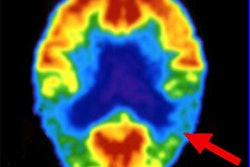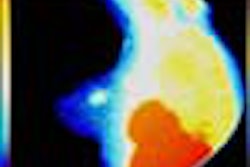(Ultrasound Review) The cavum septum pellucidum (CSP) is a cerebral cavity commonly demonstrated on ultrasound examinations performed during the second and third trimesters. Absence of the CSP is characteristic of brain abnormalities, such as agenesis of the corpus callosum, holoprosencephaly, septo-optic dysplasia, and schizencephaly.
Researchers from the University of Bologna determined the rate of visualization and size of the CSP in a study of 286 consecutive uncomplicated pregnancies. Their findings were recently published in Ultrasound in Obstetrics and Gynecology.
"The CSP was seen in 40% of cases at 15 weeks, 82% at 16-17 weeks, 100% at 18-37 weeks, and 79% at 38-41 weeks," the authors said. A normal variant called a cavum vergae is present when the CSP extends caudally, "forming a pouch in close proximity with the distal callosum."
In this study, the AP diameter of the CSP was measured in the axial transventricular plane that is used for the BPD measurement. The authors derived an equation for the relationship between CSP width and gestational age, and this is detailed as follows:
CSP (mm) = – 5.51374 + 0.70287 x weeks – 0.01008 x weeks2
The CSP should always be visualized between 18-37 weeks, but failure to demonstrate it before 18 or after 37 weeks’ gestation does not necessarily warrant further investigation. Their explanation for the decrease in size at term was that the fluid within the CSP becomes reabsorbed in late pregnancy.
Other authors have stated that the majority of CNS abnormalities can be detected through visualization of the lateral ventricles and the cisterna magna. The authors argue that failure to show the CSP in the axis they have described "may be the only sign of complete agenesis of the corpus callosum, one of the most frequent cerebral malformations."
If the CSP is not shown at 18-37 weeks’ gestation, or if an enlarged CSP is shown, this may be indicative of abnormal brain development, and further investigation should be considered.
"Transabdominal sonography of the cavum septum pellucidum in normal fetuses in the second and third trimesters of pregnancy"
P Falco et al
Dr Gianluigi Pilu, Clinica Ginecologica e Ostetrica, Policlinico Sant’Orsola-Malpighi, Via Massarenti 13, 40138, Bologna, Italy
Ultrasound Obstet Gynecol (November) 2000; 16:549–553
By Ultrasound Review
March 26, 2001
Click here to post your comments about this story. Please include the headline of the article in your message.
Copyright © 2001 AuntMinnie.com



















